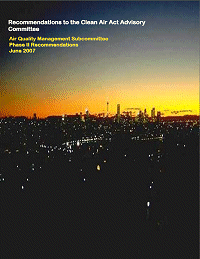Air Quality Management Plan
Basic Information
 |
| “Air Quality Management in the United States (PDF),” (99pp, 1.4 MB) |
EPA is working with three areas to pilot the concept of integrating federal, state, and tribal air quality management requirements into a comprehensive Air Quality Management Plan (AQMP). This integrated approach is consistent with the 2004 National Academy of Science report, “Air Quality Management in the United States (PDF),” (99pp, 1.4 MB) and the 2007 Clean Air Act Advisory Committee recommendations. The three areas that are piloting the AQMP: New York, North Carolina and St. Louis, MO-IL.
The areas have each agreed to develop a multi-pollutant focused AQMP that will involve appropriate stakeholders and will outline how the participating agency plans to address air pollutants in an integrated manner. Each area may include considerations of ecosystem impacts and air quality linkages to energy, land-use, transportation and other non-traditional policies. Each AQMP will include a set of pollution reduction strategies that demonstrate one or more of the following:
- attainment/maintenance of the National Ambient Air Quality Standards,
- risk reductions from Hazardous Air Pollutants,
- improvements in visibility and ecosystem health, and
- integration with land use, transportation, energy and climate.
EPA is providing policy and technical assistance to the pilot areas. This will include program coordination, legal and policy consultation, information about emission inventories, information on multi-pollutant control measures and costs, support for air quality modeling and exposure/benefits assessment.
